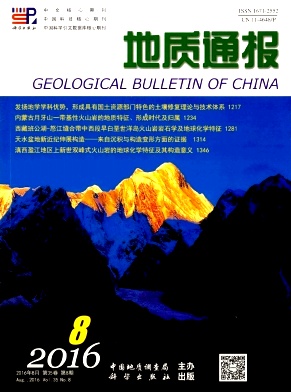| [1] |
Voight B,Faust C.Frictional heat and strength loss in some rapid landslides:error correction and affirmation of mechanism for the Vaiont landslide[J].Geotechnique,1992,42:641-643.
Google Scholar
|
| [2] |
Plafker G,Ericksen G E,Concha J F.Geological aspects of the May 31,1970 Peru earthquake[J].Seismological Society of America Bulletin,1971,61(3):543-578.
Google Scholar
|
| [3] |
黄润秋,许强.中国典型灾难性滑坡[M].2008,北京:科学出版社.
Google Scholar
|
| [4] |
Weidinger J T.Landslide Dams in the High Mountains of India,Nepal and China-Stability and Life Span of Their Dammed Lakes[J].Italian Journal of Engineering Geology and Environment,2006,Special Issue (1):67-80.
Google Scholar
|
| [5] |
吕艳,王根龙,张新社.翠华山山崩地质遗迹景观离散元数值模拟[J].工程地质学报,2013,21(3):443-449.
Google Scholar
|
| [6] |
黄润秋.20世纪以来中国的大型滑坡及其发生机制[J].岩石力学与工程学报,2007,26(3):433-454.
Google Scholar
|
| [7] |
刘伟.西藏易贡巨型超高速远程滑坡地质灾害链特征研析[J].中国地质灾害与防治学报,2002,13(3):9-18.
Google Scholar
|
| [8] |
吕杰堂,王治华,周成虎.西藏易贡大滑坡成因探讨[J].地球科学(中国地质大学学报),2003,28(1):107-110.
Google Scholar
|
| [9] |
Yin Y P,Xing A G.Aerodynamic modeling of the Yigong gigantic rock slide-debris avalanche,Tibet,China[J].Bulletin of Engineering Geology and the Environment,2011,71:149-160.
Google Scholar
|
| [10] |
Xu Q,Shang Y J,van Asch T,et al.Observations from the large,rapid Yigong rock slide-debris avalanche,southeast Tibet[J].Canadian Geotechnical Journal,2012,49:589-606.
Google Scholar
|
| [11] |
Shang Y J,Yang Z F,Li L,et al.A super-large landslide in Tibet in 2000:background,occurrence,disaster,and origin[J].Geomorphology,2003,54:225-243.
Google Scholar
|
| [12] |
黄润秋,裴向军,李天斌.汶川地震触发大光包巨型滑坡基本特征及形成机理分析[J].工程地质学报,2008,16(6):730-742.
Google Scholar
|
| [13] |
殷跃平.汶川八级地震滑坡高速远程特征分析[J].工程地质学报,2009,17(2):153-166.
Google Scholar
|
| [14] |
张永双,雷伟志,石菊松,等.四川5.12地震次生地质灾害的基本特征初析[J].地质力学学报,2008,14(2):109-116.
Google Scholar
|
| [15] |
张永双,石菊松,孙萍,等.汶川地震内外动力耦合及灾害实例[J].地质力学学报,2009,15(2):131-142.
Google Scholar
|
| [16] |
张永双,苏生瑞,吴树仁,等.强震区断裂活动与大型滑坡关系研究[J].岩石力学与工程学报,2011,28(s2):3503-3513.
Google Scholar
|
| [17] |
王秀英,聂高众,王登伟.四川汶川地震诱发滑坡与地震动峰值加速度对应关系研究[J].岩石力学与工程学报,2010,29(1):159-165.
Google Scholar
|
| [18] |
张明,殷跃平,吴树仁,等.高速远程滑坡-碎屑流运动机理研究发展现状与展望[J].工程地质学报,2010,18(6):805-818.
Google Scholar
|
| [19] |
程谦恭,王玉峰,朱圻,等.高速远程滑坡超前冲击气浪动力学机理[J].2011,29(1):70-80.
Google Scholar
|
| [20] |
Scheidegger A E.On the prediction of the reach and velocity of catastrophic landslides[J].Rock Mechanics,1973,5:231-236.
Google Scholar
|
| [21] |
殷跃平,朱继良,杨胜元.贵州关岭大寨高速远程滑坡-碎屑流研究[J].工程地质学报,2010,18(4):445-455.
Google Scholar
|
| [22] |
唐川.昭通头寨沟特大型灾害性滑坡研究[J].云南地理环境研究,1991,2(2):64-71.
Google Scholar
|
| [23] |
Sassa K.The mechanism starting liquefied landslides and debris flows[C]//Proceedings of the 4th International Symposium on Landslides.Rotterdam:Balkema A A,1984,2:349-354.
Google Scholar
|
| [24] |
Sassa K,Fukuoka H,Wang G,et al.Undrained dynamic-loading ring-shear apparatus and its application to landslide dynamics[J].Landslides,2004,1:7-19.
Google Scholar
|
| [25] |
汪发武.高速滑坡形成机制:土粒子破碎导致超孔隙水压力的产生[J].长春科技大学学报,2001,1(31):64-69.
Google Scholar
|
| [26] |
Wang F W,Sassa K,Wang G H.Mechanism of a long-runout landslide triggered by the August 1998 heavy rainfall in Fukushima Prefecture,Japan[J].Engineering Geology,2002,(63):169-185.
Google Scholar
|
| [27] |
邢爱国.云南头寨大型高速岩质滑坡流体动力学机理的研究[J].岩石力学与工程学报,2002,21(4):614-614.
Google Scholar
|
| [28] |
邢爱国,高广运,陈龙珠,等.大型高速滑坡启程流体动力学机理研究[J].岩石力学与工程学报,2004,23(4):607-613.
Google Scholar
|
| [29] |
Muller L.New considerations on the Vaiont slide[J].Rock Mechanics&Engineering Geology,1968,6(1/2):4-91.
Google Scholar
|
| [30] |
孙萍,张永双,殷跃平,等.东河口滑坡-碎屑流高速远程运移机制探讨[J].工程地质学报,2009,17(6):737-744.
Google Scholar
|
| [31] |
Sun P,Zhang Y S,Shi J S,et al.Analysis on the dynamical process of Donghekou rockslide-debris flow triggered by 5.12 Wenchuan earthquake[J].Journal of Mountain Science,2011,8(2):140-148.
Google Scholar
|
| [32] |
胡明鉴,程谦恭,汪发武.易贡远程高速滑坡形成原因试验探索[J].岩石力学与工程学报,2009,28(1):138-143.
Google Scholar
|
| [33] |
Skempton,A W.Residual strength of clays in landslides,folded strata and the laboratory[J].Geotechnique,1985,35(1):3-18.
Google Scholar
|
| [34] |
龙建辉.高速远程黄土滑坡预测预报方法研究[D].长安大学博士学位论文,2008.
Google Scholar
|
| [35] |
许强,董秀军.汶川地震大型滑坡成因模式[J].地球科学——中国地质大学学报,2011,36(6):1134-1142.
Google Scholar
|
| [36] |
徐峻龄.中国的高速滑坡及其基本类型[J].中国地质灾害与防治学报,1994,5(s):24-29.
Google Scholar
|
| [37] |
黄润秋,裴向军,张伟锋,等.再论大光包滑坡特征与形成机制[J].工程地质学报,2009,17(6):725-12.
Google Scholar
|
| [38] |
岳中琦.汶川地震与山崩地裂的极高压甲烷天然气成因和机理[J].地学前缘,2013,20(6):15-20.
Google Scholar
|
| [39] |
岳中琦.汶川地震成因的龙门山断裂带异常高压天然气体力源简述[J].岩石力学与工程动态,2009,2:45-51.
Google Scholar
|
| [40] |
赵京轶,汤倩,兰晓雯,等.地下高压气体对汶川地震灾害的作用分析[J].震灾防御技术,2009,4(4):406-416.
Google Scholar
|
| [41] |
Zhang Y S,Zhao X T,Lan H X,et al.A Pleistocene landslidedammed lake,Jinsha River,Yunnan,China[J].Quaternary International,2011,233:72-80.
Google Scholar
|
| [42] |
Kent P E.The transport mechanism in catastrophic rock falls[J].Geology,1966,74:79-83.
Google Scholar
|
| [43] |
龙德雄,黄辅琼,官致君,等.四川理塘毛垭温泉地质构造环境及成因分析[J].四川地震,2006,1:34-40.
Google Scholar
|
| [44] |
徐锡伟,闻学泽,于贵华,等.川西理塘断裂带平均滑动速率、地震破裂分段与复发特征[J].中国科学(D辑),2005,35(6):540-551.
Google Scholar
|
| [45] |
王治华,吕杰堂.从卫星图像上认识西藏易贡滑坡[J].遥感学报,2001,5(4):312-317.
Google Scholar
|
| [46] |
杨保.青藏高原地区过去2000年来的气候变化[J].地球科学进展,2003,18(2):285-292.
Google Scholar
|
| [47] |
Schneider D,Huggel C,Haeberli W,et al.Unraveling driving factors for large rock-ice avalanche mobility[J].Earth Surface Processes and Landforms,2011,36:1948-1966.
Google Scholar
|
| [48] |
刘嘉麒,倪云燕,储国强.第四纪的主要气候事件[J].第四纪研究,2001,21(3):239-248.
Google Scholar
|
| [49] |
O'Connor J E,Costa J E.Geologic and hydrologic hazards in glacierized basins in North America resulting from 19th and 20th century global warming[J].Natural Hazards,1993,8(2):121-140.
Google Scholar
|
| [50] |
Haeberli W,Hohmann R.Climate,glaciers and permafrost in the Swiss Alps 2050:scenarios,consequences and recommendations[C]//Kane D L,Hinkel K M.Ninth International Conference on Permafrost,University of Alaska,Fairbanks:Fairbanks,Alaska,2008:607-612.
Google Scholar
|
| [51] |
Hewitt K,Clague J J,Orwin J F.Legacies of catastrophic rock slope failures in mountain landscapes[J].Earth-Science Reviews,2008,87:1-38.
Google Scholar
|
| [52] |
Radic V,Hock R.Regionally differentiated contribution of mountain glaciers and ice caps to future sea-level rise[J].Nature Geoscience,2011,4(2):91-94.
Google Scholar
|
| [53] |
Chen J,Dai F C,Lv T Y,et al.Holocene landslide-dammed lake deposits in the Upper Jinsha River,SE Tibetan Plateau and their ages[J].Quaternary International,2013,298:107-113.
Google Scholar
|






 DownLoad:
DownLoad: